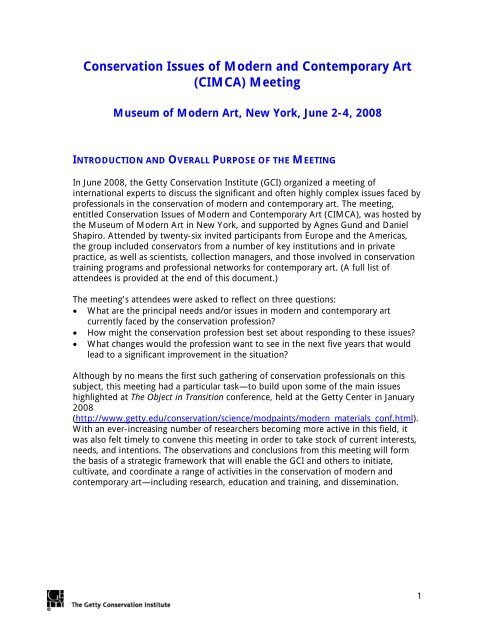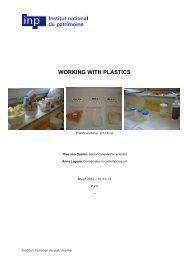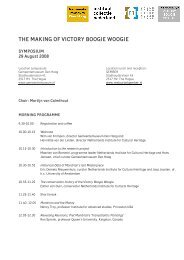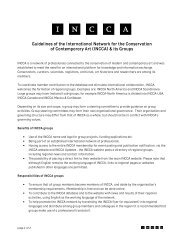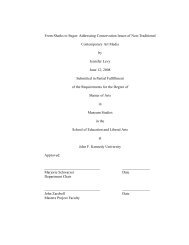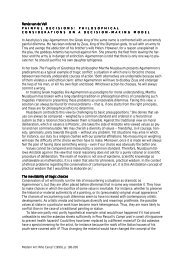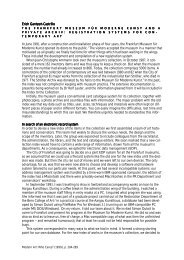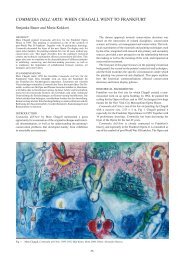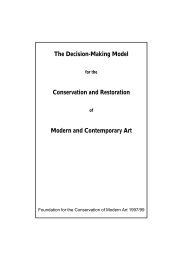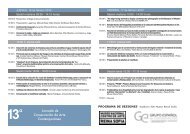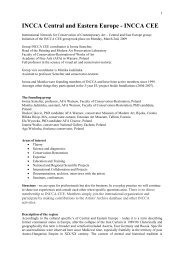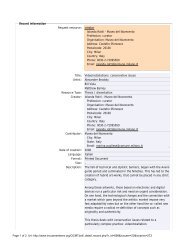Conservation Issues of Modern and Contemporary Art ... - The Getty
Conservation Issues of Modern and Contemporary Art ... - The Getty
Conservation Issues of Modern and Contemporary Art ... - The Getty
You also want an ePaper? Increase the reach of your titles
YUMPU automatically turns print PDFs into web optimized ePapers that Google loves.
<strong>Conservation</strong> <strong>Issues</strong> <strong>of</strong> <strong>Modern</strong> <strong>and</strong> <strong>Contemporary</strong> <strong>Art</strong><br />
(CIMCA) Meeting<br />
Museum <strong>of</strong> <strong>Modern</strong> <strong>Art</strong>, New York, June 2-4, 2008<br />
INTRODUCTION AND OVERALL PURPOSE OF THE MEETING<br />
In June 2008, the <strong>Getty</strong> <strong>Conservation</strong> Institute (GCI) organized a meeting <strong>of</strong><br />
international experts to discuss the significant <strong>and</strong> <strong>of</strong>ten highly complex issues faced by<br />
pr<strong>of</strong>essionals in the conservation <strong>of</strong> modern <strong>and</strong> contemporary art. <strong>The</strong> meeting,<br />
entitled <strong>Conservation</strong> <strong>Issues</strong> <strong>of</strong> <strong>Modern</strong> <strong>and</strong> <strong>Contemporary</strong> <strong>Art</strong> (CIMCA), was hosted by<br />
the Museum <strong>of</strong> <strong>Modern</strong> <strong>Art</strong> in New York, <strong>and</strong> supported by Agnes Gund <strong>and</strong> Daniel<br />
Shapiro. Attended by twenty-six invited participants from Europe <strong>and</strong> the Americas,<br />
the group included conservators from a number <strong>of</strong> key institutions <strong>and</strong> in private<br />
practice, as well as scientists, collection managers, <strong>and</strong> those involved in conservation<br />
training programs <strong>and</strong> pr<strong>of</strong>essional networks for contemporary art. (A full list <strong>of</strong><br />
attendees is provided at the end <strong>of</strong> this document.)<br />
<strong>The</strong> meeting’s attendees were asked to reflect on three questions:<br />
• What are the principal needs <strong>and</strong>/or issues in modern <strong>and</strong> contemporary art<br />
currently faced by the conservation pr<strong>of</strong>ession?<br />
• How might the conservation pr<strong>of</strong>ession best set about responding to these issues?<br />
• What changes would the pr<strong>of</strong>ession want to see in the next five years that would<br />
lead to a significant improvement in the situation?<br />
Although by no means the first such gathering <strong>of</strong> conservation pr<strong>of</strong>essionals on this<br />
subject, this meeting had a particular task—to build upon some <strong>of</strong> the main issues<br />
highlighted at <strong>The</strong> Object in Transition conference, held at the <strong>Getty</strong> Center in January<br />
2008<br />
(http://www.getty.edu/conservation/science/modpaints/modern_materials_conf.html).<br />
With an ever-increasing number <strong>of</strong> researchers becoming more active in this field, it<br />
was also felt timely to convene this meeting in order to take stock <strong>of</strong> current interests,<br />
needs, <strong>and</strong> intentions. <strong>The</strong> observations <strong>and</strong> conclusions from this meeting will form<br />
the basis <strong>of</strong> a strategic framework that will enable the GCI <strong>and</strong> others to initiate,<br />
cultivate, <strong>and</strong> coordinate a range <strong>of</strong> activities in the conservation <strong>of</strong> modern <strong>and</strong><br />
contemporary art—including research, education <strong>and</strong> training, <strong>and</strong> dissemination.<br />
1
ISSUES<br />
<strong>The</strong> primary issues identified by the meeting participants were grouped into six broad<br />
categories:<br />
• research into modern materials;<br />
• research into conservation treatments;<br />
• ethical/theoretical issues;<br />
• documentation;<br />
• dissemination <strong>and</strong> information sharing;<br />
• education <strong>and</strong> training.<br />
Research into <strong>Modern</strong> Materials<br />
Despite recent <strong>and</strong> significant advances in the conservation pr<strong>of</strong>ession’s knowledge <strong>of</strong><br />
some <strong>of</strong> the materials used in modern <strong>and</strong> contemporary art—in particular, modern<br />
paints—there remains a severe lack <strong>of</strong> information regarding the vast majority <strong>of</strong><br />
modern/contemporary materials, in terms <strong>of</strong> underst<strong>and</strong>ing how they behave (either<br />
alone or in combination with other materials), <strong>and</strong> how they might alter with age, in<br />
storage, with treatment, <strong>and</strong>/or in transit, etc. Specifically, there is a clear need for:<br />
• further characterization <strong>of</strong> these materials to underst<strong>and</strong> their chemistry <strong>and</strong><br />
condition, <strong>and</strong> how they are likely to alter/deteriorate with age;<br />
• improved access to existing methods <strong>of</strong> analysis <strong>and</strong> characterization, especially<br />
for private studios/smaller museums, either through h<strong>and</strong>-held instruments or<br />
closer collaborations with analysts/conservation scientists;<br />
• more portable analytical instruments for in situ identification <strong>of</strong> materials in<br />
actual objects—in particular, for rapid surveying <strong>of</strong> large collections <strong>of</strong> disparate<br />
materials;<br />
• more portable analytical instruments for in situ monitoring <strong>of</strong> chemical,<br />
physical, <strong>and</strong>/or surface changes in objects with age <strong>and</strong>/or after treatments;<br />
• better documented, accessible, <strong>and</strong> reliable collections <strong>of</strong> reference materials<br />
with which analytical methods for identification can be developed <strong>and</strong> aging<br />
studies conducted;<br />
• establishing the optimum environmental conditions/strategies for the display<br />
<strong>and</strong> storage <strong>of</strong> all modern <strong>and</strong> contemporary materials;<br />
• determining guidelines for the packing <strong>and</strong> transportation <strong>of</strong> modern <strong>and</strong><br />
contemporary works <strong>of</strong> art.<br />
Research into <strong>Conservation</strong> Treatments<br />
Conservators <strong>of</strong>ten have to carry out treatments on modern <strong>and</strong> contemporary art<br />
works with a limited range <strong>of</strong> appropriate materials <strong>and</strong> treatment options, <strong>and</strong><br />
without the desired level <strong>of</strong> underst<strong>and</strong>ing <strong>of</strong> the materials/process themselves <strong>and</strong>/or<br />
the long-term consequences <strong>of</strong> their use. <strong>The</strong>re appear to be two main factors<br />
hampering progress in this area: 1) a lack <strong>of</strong> research focusing on developing new <strong>and</strong><br />
novel conservation treatments <strong>and</strong>/or materials; <strong>and</strong> 2) a lack <strong>of</strong> experience <strong>and</strong> case<br />
studies on which conservators can evaluate the longer-term success <strong>of</strong> previous<br />
treatments. In many cases this has lead to reluctance by conservators to execute<br />
treatments—which, in turn, means that future generations <strong>of</strong> conservators may have<br />
access to even fewer case studies on which they can establish the success or failure <strong>of</strong><br />
treatments.<br />
2
An initial attempt to establish a list <strong>of</strong> concerns for treatments identified the following:<br />
• cleaning <strong>of</strong> all non-varnished/uncoated surfaces;<br />
• removing stains from raw canvas;<br />
• dealing with surface blemishes on monochromatic paintings;<br />
• removing imbibed materials from acrylic paints;<br />
• difficulties in color-matching synthetic organic pigments.<br />
A wish list for better conservation materials included:<br />
• a broader range <strong>of</strong> in-painting media, especially water-based media <strong>and</strong> media<br />
for matt surfaces;<br />
• consolidants for matt surfaces (i.e., with low refractive index);<br />
• stable <strong>and</strong> better-tested UV protective coatings (that could be applied to a<br />
range <strong>of</strong> different materials to slow down their deterioration);<br />
• thixotropic lining adhesives.<br />
Ethical/<strong>The</strong>oretical <strong>Issues</strong><br />
Many <strong>of</strong> the difficult decisions faced by conservators for modern <strong>and</strong> contemporary art<br />
pose highly complex, ethical dilemmas, <strong>and</strong> in numerous instances there are clear<br />
disagreements within the conservation pr<strong>of</strong>ession—as well as among other parts <strong>of</strong> the<br />
art world—on how to resolve conflicting values. <strong>Art</strong> history <strong>and</strong> conservation have<br />
traditionally relied on the authority that each field brings to an artwork's meaning <strong>and</strong><br />
underst<strong>and</strong>ing. This is now under some re-evaluation when it comes to contemporary<br />
works. Not only is there a certain curatorial/conservation blur when it comes to<br />
questions <strong>of</strong> meaning <strong>and</strong> material, with contemporary works there is an inherent<br />
resistance to shutting down interpretive possibilities for works that have not yet lived<br />
in the world. <strong>The</strong>re therefore appears to be a particular need for a far more active<br />
interdisciplinary dialogue with other areas <strong>of</strong> the arts pr<strong>of</strong>ession, especially art<br />
historians <strong>and</strong> curators, <strong>and</strong> for more opportunities for theoretical research projects<br />
<strong>and</strong>/or masters/doctoral theses to be undertaken.<br />
Some specific issues raised were a need to:<br />
• rethink <strong>and</strong> revise the traditional <strong>and</strong> strict role definitions <strong>of</strong> the conservator,<br />
researcher, artist (or their estate), art historian, curator, dealer, valuer, insurance<br />
agent, <strong>and</strong> others;<br />
• identify, weigh, <strong>and</strong> navigate a different set <strong>of</strong> values in works <strong>of</strong> modern <strong>and</strong><br />
contemporary art, such as meaning, function <strong>and</strong> intent, <strong>and</strong> how they will all<br />
change with time;<br />
• establish a set <strong>of</strong> ethics for the conservation <strong>of</strong> ephemeral/transitory art;<br />
• assess further the implications <strong>of</strong> making replicas <strong>of</strong> works <strong>of</strong> art, particularly for<br />
those works that have altered dramatically with time;<br />
• develop additional appropriate forums to discuss these issues in a cross–<br />
disciplinary way.<br />
Documentation<br />
Considerable amounts <strong>of</strong> time <strong>and</strong> resources are currently placed on gathering<br />
information on modern <strong>and</strong> contemporary art for documentation purposes,<br />
especially—but not exclusively—for museum collections. However, this creates its own<br />
3
set <strong>of</strong> issues, in particular the need to consider several new aspects in works <strong>of</strong><br />
contemporary art that should be documented beyond the physical object—such as the<br />
significance, value, <strong>and</strong> meaning <strong>of</strong> materials, sound, motion, <strong>and</strong> even smell—<strong>and</strong> to<br />
develop strategies <strong>and</strong> methodologies for documenting them. It is also imperative that<br />
a more st<strong>and</strong>ardized terminology is developed within the pr<strong>of</strong>ession to ensure that this<br />
documentation is easily shared <strong>and</strong> understood.<br />
Specific issues that were identified include a need to:<br />
• <strong>of</strong>fer more descriptions <strong>of</strong> why a decision to treat an object (or not) was made;<br />
• <strong>of</strong>fer more instructions/information from the artist <strong>and</strong>/or manufacturers;<br />
• document works <strong>of</strong> art as soon as possible after they are made;<br />
• gain access to other conservators’ unpublished records/archives;<br />
• address the fact that because a diversity <strong>of</strong> approaches/models are currently<br />
used by different collections for installation art, information sharing is very<br />
difficult;<br />
• manage obsolete technology <strong>and</strong> the data from time-based media works;<br />
• devise a process to document Web art (which can suddenly disappear <strong>of</strong>fline);<br />
• develop a method to characterize the patinas on bronze sculptures.<br />
Dissemination <strong>and</strong> Information Sharing<br />
Communication <strong>and</strong> information exchange within <strong>and</strong> beyond the pr<strong>of</strong>ession is<br />
inadequate. Despite the existence <strong>of</strong> pr<strong>of</strong>essional networks—for example, INCCA (<strong>The</strong><br />
International Network for the <strong>Conservation</strong> <strong>of</strong> <strong>Contemporary</strong> <strong>Art</strong>), ICOM-CC: MMCA<br />
(the <strong>Modern</strong> Materials <strong>and</strong> <strong>Contemporary</strong> <strong>Art</strong> working group <strong>of</strong> the International<br />
Council <strong>of</strong> Museums–<strong>Conservation</strong> Committee), <strong>and</strong> AMIEN (<strong>Art</strong> Materials Information<br />
<strong>and</strong> Education Network)—these are still under-utilized; they remain, however, the<br />
logical vehicles for creating far more dynamic forms <strong>of</strong> networking <strong>and</strong> dissemination.<br />
<strong>The</strong>re is a clear need for:<br />
• improved communication among colleagues/institutions to share information<br />
more effectively on all aspects <strong>of</strong> conservation (especially research results <strong>and</strong><br />
treatment decisions);<br />
• engaging a broader cross-section <strong>of</strong> the arts pr<strong>of</strong>ession (especially art historians,<br />
artists, collectors, <strong>and</strong> curators) in many <strong>of</strong> the discussions;<br />
• identifying more experts from other fields (e.g., structural engineers <strong>and</strong> video<br />
technicians) who could share useful advice <strong>and</strong> experience on specific issues<br />
<strong>and</strong> types <strong>of</strong> artwork;<br />
• raising awareness within the public through many <strong>of</strong> the discussions <strong>and</strong><br />
debates.<br />
Education <strong>and</strong> Training<br />
It was recognized that the training <strong>and</strong> education <strong>of</strong> more conservators in modern <strong>and</strong><br />
contemporary art is key to progress in the field, <strong>and</strong> that the majority <strong>of</strong> conservation<br />
training programs are already attempting to respond to this need. <strong>The</strong>re remains,<br />
however, a significant amount <strong>of</strong> disagreement on how best to achieve the most<br />
appropriate training for such conservators, <strong>and</strong> on how to get around the limitations <strong>of</strong><br />
existing educational models. Other levels <strong>of</strong> education <strong>and</strong> training possibilities are<br />
also lacking—for example, pre-program <strong>and</strong> mid-career opportunities.<br />
4
It was felt that there is a need to:<br />
• consider a more cross-disciplinary track (i.e., to move away from the<br />
conventional materials-based divisions) at the training programs;<br />
• identify a new skills set for conservators <strong>of</strong> modern <strong>and</strong> contemporary art;<br />
• establish opportunities for PhD research in theory/ethics <strong>and</strong> conservation<br />
science;<br />
• establish opportunities for sabbaticals/mid-career exchanges;<br />
• improve public awareness <strong>of</strong> issues;<br />
• broaden demographics <strong>of</strong> the field, <strong>and</strong> attract students from a wider<br />
background <strong>of</strong> education styles/subjects.<br />
5
POTENTIAL RESPONSES TO THESE NEEDS<br />
<strong>The</strong> suggested responses for all six categories <strong>of</strong> issues fell into four areas: research,<br />
documentation, dissemination, <strong>and</strong> training <strong>and</strong> education.<br />
Research<br />
Clearly, increased research into many <strong>of</strong> the identified issues—for both<br />
modern/contemporary materials <strong>and</strong> for the development <strong>of</strong> more appropriate<br />
conservation treatments—would be an effective response. It was felt that the<br />
conservation pr<strong>of</strong>ession should attempt to establish a well-integrated network <strong>of</strong><br />
researchers <strong>and</strong>/or a high level <strong>of</strong> collaboration in order to avoid unnecessary<br />
duplication, <strong>and</strong> to facilitate the evaluation <strong>of</strong> different approaches taken. It was<br />
deemed particularly important to encourage a range <strong>of</strong> approaches to developing <strong>and</strong><br />
testing conservation treatments, due to the inevitable uncertainties <strong>of</strong> aging processes,<br />
resulting in an inability to properly evaluate success for many years. Breaking up some<br />
<strong>of</strong> the larger, long-term research projects into smaller units would also have significant<br />
benefits. Some <strong>of</strong> the larger research projects identified include:<br />
Aging <strong>of</strong> <strong>Modern</strong> Materials<br />
• Establish more complete data on the aging <strong>of</strong> coatings, adhesives, <strong>and</strong><br />
consolidants.<br />
• Develop methods to monitor surface changes.<br />
• Improve non-destructive means to assess the structural stability <strong>of</strong> materials.<br />
• Develop methods to stabilize cellulose acetate (CA) <strong>and</strong> cellulose nitrate (CN)<br />
plastics.<br />
• Study further the aging processes involved in modern oils to better underst<strong>and</strong><br />
water-sensitive oils, liquefying oil paints, <strong>and</strong> efflorescence.<br />
Preventive <strong>Conservation</strong><br />
• Compare current state <strong>of</strong> thinking <strong>and</strong> practice regarding climate guidelines,<br />
control, <strong>and</strong> management in different museums <strong>and</strong> collections, either by a<br />
survey or with a meeting to compare/contrast the various approaches <strong>and</strong><br />
policies.<br />
• Gather data on the behavior <strong>of</strong> different materials to different environmental<br />
conditions in order to develop knowledge (<strong>and</strong> ultimately guidelines) for<br />
optimum storage or display conditions for these materials/objects.<br />
• Assess the implications for storage <strong>of</strong> objects in crates: design <strong>of</strong> crates,<br />
interaction <strong>of</strong> materials, <strong>of</strong>f-gassing, etc.<br />
• Assess the implications <strong>of</strong> climate change <strong>and</strong> sustainability issues, which are<br />
set to impact heavily all areas <strong>of</strong> cultural heritage conservation in the near<br />
future.<br />
• Assess the increase in longevity <strong>of</strong> face-mounted photographs in cold storage.<br />
• Establish guidelines (for packers <strong>and</strong> artists) for the display <strong>and</strong> transportation<br />
<strong>of</strong> modern <strong>and</strong> contemporary works <strong>of</strong> art (especially the effects <strong>of</strong> vibration on<br />
3D objects), <strong>and</strong> design better wrapping methods for unvarnished paintings.<br />
6
Research into <strong>Conservation</strong> Treatments <strong>and</strong> Materials<br />
• Make stronger connections with industrial partners (e.g., Rohm & Haas) to tap<br />
into their knowledge <strong>and</strong> expertise on resins <strong>and</strong> coatings.<br />
• Increase involvement <strong>of</strong> conservators in evaluating the success <strong>of</strong> treatments<br />
from a more practical <strong>and</strong> empirical st<strong>and</strong>point.<br />
• Establish, whenever possible, practical research efforts that test multiple<br />
treatment approaches.<br />
New Instruments/Methodologies<br />
Develop methods for improved, scientific documentation <strong>of</strong> change—especially<br />
portable, non-invasive, low cost, <strong>and</strong> yet still high-tech instruments. It was stressed<br />
that for all such development, it would be important to concentrate on changes<br />
that are significant (e.g., weak links or irreplaceable components). Some specific<br />
ideas included:<br />
• better methods for characterization <strong>of</strong> surfaces (texture, gloss, transparency) to<br />
assess the effects <strong>of</strong> aging <strong>and</strong> treatments;<br />
• development <strong>of</strong> non-invasive deterioration indicators (e.g., peroxide formation);<br />
• development <strong>of</strong> improved methods <strong>of</strong> characterizing/describing patinas on<br />
bronzes;<br />
• assessment <strong>of</strong> new methods (e.g., mechanical techniques, laser techniques) for<br />
cleaning non-varnished surfaces, especially on monochrome paintings.<br />
Time-Based Media: Magnetic Media <strong>and</strong> Digital <strong>Art</strong><br />
• Bring established technical knowledge to the art world.<br />
• Create guidelines for mastering digital art on servers.<br />
• Develop methodologies <strong>of</strong> keeping works accessible when technologies become<br />
obsolete.<br />
<strong>Contemporary</strong> <strong>Art</strong> in Tropical Climates<br />
• Develop methods to prevent <strong>and</strong> treat mold growth.<br />
• Revisit the pros <strong>and</strong> cons <strong>of</strong> microclimates (e.g., glazing <strong>and</strong>/or applying<br />
backboards) for paintings<br />
• Refine management systems for climatic extremes.<br />
• Study salt degradation <strong>of</strong> oil paints.<br />
Documentation<br />
A number <strong>of</strong> ways in which the new needs for documentation practice could be<br />
addressed in general were identified, as well as some specific responses for installation<br />
<strong>and</strong> digital art.<br />
General<br />
• Develop better links with more artists <strong>and</strong>/or artist estates, to ensure continued<br />
access to any information held by them.<br />
• Document contemporary art at the earliest possible moment, <strong>and</strong> continue to<br />
monitor changes.<br />
• Improve methods for data collection (artists’ interviews, etc.).<br />
• Improve access to oral histories.<br />
7
• Create more documentation specialists (e.g., Tate’s Information Coordinator).<br />
• Establish a st<strong>and</strong>ard terminology.<br />
Installation <strong>Art</strong><br />
• Create, share, <strong>and</strong> test models <strong>and</strong> new technologies for documentation <strong>of</strong><br />
installation art that include new parameters: light, sound, motion, 3D, etc.,<br />
building on those explored in the Inside Installations project<br />
(http://www.inside-installations.org).<br />
• Test documentation models <strong>and</strong> technologies via installations at other<br />
institutions.<br />
• Encourage more collectors/institutions to test models <strong>and</strong> provide accessible<br />
case studies.<br />
• Create best practice guides.<br />
• Work toward a methodological approach.<br />
Time-Based Media<br />
• Evaluate <strong>and</strong> utilize existing methods for documenting moving images (such as<br />
those used in libraries, industry, etc.) for time-based media.<br />
Dissemination<br />
Dissemination <strong>and</strong> information sharing are considered absolutely key to improving the<br />
field, in both the short-term <strong>and</strong> the long-term. A number <strong>of</strong> ideas were discussed on<br />
how to facilitate the exchange <strong>of</strong> information <strong>and</strong> experiences.<br />
Publications<br />
Dissemination <strong>and</strong> information sharing ideas related to publications included:<br />
• launching an online peer reviewed journal that would link conservation, art<br />
history thinking <strong>and</strong> research, <strong>and</strong> beyond (e.g., visual culture, sociology, etc.),<br />
in recognition <strong>of</strong> the fact that all these perspectives inform the way we look at<br />
<strong>and</strong> live with art made in our time;<br />
• making far better use <strong>of</strong> existing journals—for example, Reviews in <strong>Conservation</strong><br />
for overviews <strong>of</strong> the pr<strong>of</strong>ession to date, <strong>and</strong> <strong>Art</strong> Forum <strong>and</strong> Future Anterior—to<br />
target the interdisciplinary audience <strong>of</strong> conservators <strong>and</strong> art historians;<br />
• facilitating access to master’s theses <strong>and</strong> student research projects through links<br />
to ENCoRE, VDR, <strong>and</strong> ANAGPIC.<br />
Conferences<br />
Conferences are still viewed as essential to the field in terms <strong>of</strong> keeping abreast <strong>of</strong><br />
current research, as well as fostering larger debates through panel discussions <strong>and</strong><br />
audience participation. It was thought that, ideally, a series <strong>of</strong> conferences could be<br />
developed that would:<br />
• be attended by a maximum <strong>of</strong> 200 people (to facilitate discussion);<br />
• be focused on a specific themes that should involve invited <strong>and</strong> targeted<br />
specialists, thereby engaging other disciplines, especially those in science;<br />
• be accompanied by a Web-based publication;<br />
• include, potentially, the following themes: coatings; failure (<strong>of</strong> materials); timebased<br />
media; ephemeral (transitory) objects; <strong>and</strong> preventive conservation.<br />
8
New Forums on the Web<br />
A number <strong>of</strong> suggestions revolved around making more use <strong>of</strong> the Web to disseminate<br />
information. <strong>The</strong>se included:<br />
• creating a series <strong>of</strong> online panel discussions with an invited group <strong>of</strong> experts, to<br />
focus on specific issues/problems, using the model <strong>of</strong> Skin Deep: Questions on<br />
the <strong>Conservation</strong> <strong>of</strong> Post-War Paintings (Collectors World Online Forum,<br />
January 29–February 15, 2003 [http://palimpsest.stanford.edu/byform/mailinglists/cdl/2003/0129.html]);<br />
• supporting INCCA to be a clearing house—the first Web site people will access<br />
to find information, or to seek links to other Web sites/publications;<br />
• drawing more attention to AMIEN, a widely accessed Web site, that is already<br />
facilitating communication between artists <strong>and</strong> conservators/conservation<br />
scientists;<br />
• encouraging all museums <strong>and</strong> research institutions to be more pro-active in<br />
linking their Web sites to those <strong>of</strong> other organizations;<br />
• initiating a discussion list/listserv for the conservation <strong>of</strong> contemporary art;<br />
• utilizing more innovative formats with improved visual layouts <strong>and</strong> more<br />
dynamic functionality (e.g., Second Life, virtual study rooms/conferences);<br />
• raising awareness with the public by utilizing the numerous Web methods for<br />
public feedback, discussion loops, <strong>and</strong> community involvement.<br />
Education <strong>and</strong> Training<br />
<strong>The</strong> conservation pr<strong>of</strong>ession needs to establish methods for improving the training <strong>of</strong><br />
modern <strong>and</strong> contemporary art conservators. It was felt that to enhance training <strong>and</strong><br />
education <strong>of</strong> conservators <strong>of</strong> modern <strong>and</strong> contemporary art it was important to<br />
consider the continuum <strong>of</strong> training from pre- through post- conservation education<br />
programs. Specific suggestions included:<br />
• increasing flexibility <strong>of</strong> programs to allow variable paths through curriculum;<br />
• establishing a conservation PhD (especially important for researching ethical<br />
<strong>and</strong> theoretical issues);<br />
• seeking a broader demographic diversity/education backgrounds in entrants to<br />
the field;<br />
• developing a series <strong>of</strong> public lectures about some <strong>of</strong> the complex issues in order<br />
to public raise awareness;<br />
• establishing a number <strong>of</strong> post-program fellowships in museums <strong>of</strong> modern <strong>and</strong><br />
contemporary art, learning from experience gained by SFMOMA;<br />
• establishing further opportunities for staff exchanges, including private as well<br />
as institutional conservators (in fact, exchanges between private <strong>and</strong><br />
institutional studios could be especially beneficial to both sectors);<br />
• assessing desirable qualities in the new breed <strong>of</strong> modern <strong>and</strong> contemporary art<br />
conservator (e.g., problem solving skills, ability to evaluate complex <strong>and</strong><br />
abstract data, ability to make collaborative decisions, ability to arrive at<br />
negotiated outcomes, skills in engineering or structural issues, <strong>and</strong> experience<br />
with all aspects <strong>of</strong> digital imaging <strong>and</strong> processing).<br />
9
PRIORITIES<br />
Although the difficulties <strong>and</strong> limitations in setting priorities were recognized, the<br />
following short- <strong>and</strong> long-term priorities were identified.<br />
Research<br />
• Increase focus on preventive conservation issues, including evaluation <strong>of</strong><br />
optimum environmental conditions for modern materials.<br />
• Develop more portable analytical instruments for materials identification,<br />
condition assessment, <strong>and</strong> surfaces characterization.<br />
• Continue <strong>and</strong> exp<strong>and</strong> studies on cleaning modern painted surfaces, with the<br />
specific requirement that the results be made very accessible to conservators.<br />
• Increase study <strong>of</strong> time-based media conservation.<br />
• Provide greater access to existing research on magnetic tape <strong>and</strong> digital media.<br />
• Conduct more research on coatings <strong>and</strong> adhesives.<br />
• Increase study <strong>of</strong> the effects <strong>of</strong> tropical climates on modern <strong>and</strong> contemporary<br />
art (including a reassessment <strong>of</strong> micro-climates).<br />
Documentation<br />
• Develop st<strong>and</strong>ard methodologies <strong>and</strong> test new technologies for the<br />
documentation <strong>of</strong> installation art.<br />
Dissemination<br />
• Establish a series <strong>of</strong> conferences focused on specific issues.<br />
• Support <strong>and</strong> improve INCCA for information dissemination.<br />
• Use IIC/ICOM-CC meetings to report on the CIMCA meeting <strong>and</strong> to encourage<br />
further feedback.<br />
• Establish online discussion forums.<br />
• Create an online inter-disciplinary journal.<br />
Training <strong>and</strong> Education<br />
• Establish a working group to discuss the pros/cons <strong>of</strong> different training program<br />
models <strong>and</strong> to consider whether to promote a unified approach or to encourage<br />
variations.<br />
• Establish <strong>and</strong> monitor further post-program training fellowships.<br />
• Create opportunities for mid-career staff exchanges <strong>and</strong> sabbaticals.<br />
• Develop more possibilities for students to spend time in artist’s studios.<br />
10
MEETING PARTICIPANTS<br />
Jim Coddington<br />
Head <strong>of</strong> <strong>Conservation</strong>, Museum <strong>of</strong> <strong>Modern</strong> <strong>Art</strong>, New York<br />
Dana Cranmer<br />
Director <strong>of</strong> Cranmer <strong>Art</strong> <strong>Conservation</strong> Inc, New York<br />
Alberto de Tagle<br />
Chief <strong>of</strong> Research, Instituut Collectie Nederl<strong>and</strong> (ICN), Amsterdam<br />
Francesca Esmay<br />
Conservator, Dia <strong>Art</strong> Foundation, New York<br />
Gunnar Heydenreich<br />
Head <strong>of</strong> Paintings <strong>and</strong> <strong>Contemporary</strong> <strong>Art</strong> <strong>Conservation</strong>, Restaurierungszentrum<br />
Düsseldorf<br />
IJsbr<strong>and</strong> Hummelen<br />
Senior Research Conservator, Instituut Collectie Nederl<strong>and</strong> (ICN), Amsterdam<br />
Jay Krueger<br />
Senior Conservator <strong>of</strong> <strong>Modern</strong> Paintings, National Gallery <strong>of</strong> <strong>Art</strong>, Washington DC<br />
Susan Lake<br />
Director <strong>of</strong> Collection Management, Hirshhorn Museum <strong>and</strong> Sculpture Garden,<br />
Washington DC<br />
Tom Learner<br />
Senior Scientist, Head <strong>of</strong> <strong>Modern</strong> <strong>and</strong> <strong>Contemporary</strong> <strong>Art</strong> Research, <strong>Getty</strong> <strong>Conservation</strong><br />
Institute, Los Angeles<br />
Carol Mancusi-Ungaro<br />
Associate Director <strong>of</strong> <strong>Conservation</strong> <strong>and</strong> Research, Whitney Museum <strong>of</strong> American <strong>Art</strong>,<br />
New York<br />
Founding Director <strong>of</strong> the Center for the Technical Study <strong>of</strong> <strong>Modern</strong> <strong>Art</strong>, Harvard<br />
University <strong>Art</strong> Museums, Cambridge.<br />
Ana Martins<br />
Associate <strong>Conservation</strong> Scientist, Museum <strong>of</strong> <strong>Modern</strong> <strong>Art</strong>, New York<br />
Michele Marincola<br />
Chairman <strong>of</strong> the <strong>Conservation</strong> Center, Institute <strong>of</strong> Fine <strong>Art</strong>s, New York University<br />
Gary Mattison<br />
Department Coordinator, <strong>Getty</strong> <strong>Conservation</strong> Institute, Los Angeles<br />
11
Christopher McGlinchey<br />
<strong>Conservation</strong> Scientist, Museum <strong>of</strong> <strong>Modern</strong> <strong>Art</strong>, New York<br />
Nancy Micklewright<br />
Senior Program Officer, <strong>Getty</strong> Foundation, Los Angeles<br />
Alan Phenix<br />
Scientist, <strong>Getty</strong> <strong>Conservation</strong> Institute, Los Angeles<br />
Derek Pullen<br />
Head <strong>of</strong> Sculpture <strong>Conservation</strong>, Tate, London<br />
Antonio Rava<br />
Director <strong>of</strong> Studio Rava, Turin<br />
Christian Scheidemann<br />
Director <strong>of</strong> <strong>Contemporary</strong> <strong>Conservation</strong> Ltd., New York<br />
Stephan Schaefer<br />
Pr<strong>of</strong>essor for Painting <strong>and</strong> <strong>Contemporary</strong> <strong>Art</strong> <strong>Conservation</strong>, Universidade Nova de<br />
Lisboa, Lisbon<br />
Michael Schilling<br />
Senior Scientist, Head <strong>of</strong> Analytical Technologies, <strong>Getty</strong> <strong>Conservation</strong> Institute, Los<br />
Angeles<br />
Luiz Souza<br />
Coordinator <strong>of</strong> LACIOR–<strong>Conservation</strong> Science Laboratory<br />
Deputy-Director <strong>of</strong> the School <strong>of</strong> Fine <strong>Art</strong>s, Federal University <strong>of</strong> Minas Gerais, Brazil<br />
Jill Sterrett<br />
Director <strong>of</strong> Collections <strong>and</strong> <strong>Conservation</strong>, San Francisco Museum <strong>of</strong> <strong>Modern</strong> <strong>Art</strong><br />
Carol Stringari<br />
Head <strong>of</strong> <strong>Conservation</strong>, Solomon R. Guggenheim Museum, New York<br />
Jeanne Marie Teutonico<br />
Associate Director <strong>of</strong> Programs, <strong>Getty</strong> <strong>Conservation</strong> Institute, Los Angeles<br />
Glenn Wharton<br />
Conservator <strong>of</strong> Time-Based Media, Museum <strong>of</strong> <strong>Modern</strong> <strong>Art</strong>, New York<br />
Research Scholar at New York University<br />
Acting Executive Director <strong>of</strong> INCCA-NA<br />
Paul Whitmore<br />
Director <strong>of</strong> the <strong>Art</strong> <strong>Conservation</strong> Research Center, Carnegie Mellon University,<br />
Pittsburgh<br />
12


